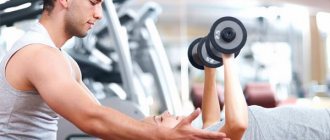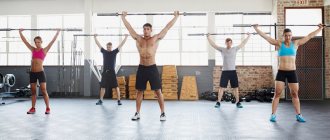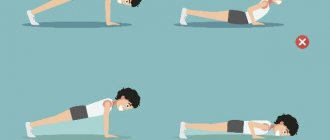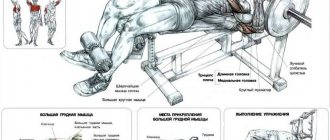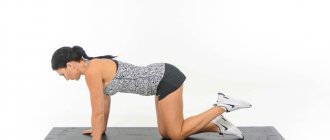What should the load interval be?
Beginners often think that the load intervals in interval training should be long and take at least a few minutes, but here the count is not in minutes, but in seconds. It is better to do more intervals, but keep them short, from 6 to 30 seconds
. In this case, you can be sure that the body will really work under increased load, and you will “give your best” to the fullest.
Any load must be justified, otherwise you risk harming yourself. During the specified interval, the muscles will be able to produce a sufficient amount of lactic acid
, but not to spend too much energy, which could lead to damage. For amateur sports, long intervals of increased load are not needed; the longer the interval, the more difficult it will be to control the load, especially if you are exercising without an instructor.
For professional athletes, the duration of intense exercise intervals can reach three minutes, but you need to understand that during this time the muscle need for oxygen and glycogen will greatly increase, and with it the risk of damage. It takes many months, or even years, to prepare for such loads, so it is better for beginners to stay in the range of 5-30 seconds
.
How to choose the right room
A well-equipped room and qualified staff will help you achieve your goals for your body. Before purchasing a subscription, it is better to take a trial lesson in the gym. Typically large networks provide this service for free. It is better if the hall is within walking distance from home or work.
What to pay attention to:
- quality of simulators;
- availability of free space in the hall;
- location of exercise equipment and equipment (so that there is no crowding around them and do not interfere with the passage);
- cleanliness in the room.
The gym must have a constant flow and flow of air. If the room is stuffy, it needs to be checked. The basic set of any fitness facility is drinking water, a locker room with lockers, a shower, a hairdryer, and a toilet. Evgeniy Grapov
For gaining muscle mass
Strength and functional training is a key way to build muscle. It is especially effective for those athletes who have not previously trained with weights. Experts recommend switching to powerlifting and bodybuilding to ensure guaranteed muscle growth, and using functional training for general strengthening of the body. What is the best way to train to gain mass:
- perform at least 12-15 repetitions in each approach;
- train no more than twice a week;
- use weight manipulations with kettlebells, barbells and dumbbells;
- perform power movements - push-ups and pull-ups;
- give one lesson to the top, the second to the bottom;
- Eat a diet rich in protein and creatine.
Principles of working on the abdominal muscles
A beautiful, flat and sculpted stomach is formed by 3 main muscles:
Rectus abdominis muscle
.
This is a large muscle that runs down from the lower ribs to the pelvis. Its task is to bend the body in the lumbar region. It is she who is responsible for the formation of “cubes”. Many people mistakenly believe that “abs” are several muscles. In fact, this is one muscle, divided in the middle by cartilage (visually it looks like a longitudinal line called the “white line”) and tendons, which form the “cubes”. Their structure is individual for each person and is not always symmetrical. Oblique abdominal muscles.
Allows you to tilt and rotate the body.
They go in two directions, intersecting each other. Attached to the lower ribs and pubic bone. Vastus abdominis muscle
. This is the deepest muscle of the abdomen, responsible for supporting the internal organs. Its fibers run across the abdomen and are attached to the ribs on both sides. The only way to work the muscle is isometric exercises.
Basic principles of working on the press:
1. Exhale while contracting the muscle. For example, when rising from a lying position. Do not hurry. Concentrate on the movement, hold the peak position for 2-3 seconds, slowly return to the starting position. The slower you move, the more fibers will be recruited. Feel that you are actually working your abdominal muscles, and not helping yourself with other muscles.
2.Keep your back straight, especially pay attention to the cervical region. If you perform exercises while lying on your back, your lower back should always touch the surface. Don't bend over or help yourself with your neck. Avoid the common mistake of moving your legs while working on your abs. Firstly, we already know that the abdominal muscles perform rotations and bending of the body and have nothing to do with the legs.
Secondly, when working with our legs, we most often use the iliopsoas muscle, which is responsible for flexing the leg at the hip joint. Strengthening this muscle can lead to serious lumbar problems in people with a large lumbar arch (lordosis). When performing crunches, you should not rise more than 30-40. It is enough to lift your shoulder blades off the floor and you can return to the starting position. When returning to the starting position during lying exercises, do not lower your shoulders all the way. Stop the return movement a few cm before the surface on which you are lying. Do 15-18 repetitions, 3 sets of each exercise. If you are doing more than 30 repetitions, then most likely you are simply working incorrectly. You need to train your abs with a break of 1-3 days.
Stretching
Abdominal muscle stretch
Stand up straight. Feet shoulder width apart. Place your hands on your buttocks. Lean back slightly. Do not allow the pelvic area to deviate forward. Stay in this position for 2 minutes
Stretching the calf muscles
Step your right foot forward and bend your right knee. The left leg should remain straight with the heel on the floor. Make sure both toes are pointing forward and the heel of your left foot and head are on the same diagonal. Stay in this position. Then switch legs and perform the exercise again.
Hamstring stretch
Lie down on the floor. Lift your right leg up with your knee bent. Grasp the thigh of your right leg with your hands and slowly straighten your leg at the knee until you feel tension in the muscles.
Quadriceps Stretch: Anterior Thigh
Extend your left arm to the side at shoulder level, or hold it against a wall or chair. Shift your body weight to your left leg and relax your knee. With your right leg bent, grab your foot with your right hand and pull it towards your buttocks. Tailor your pelvis a little. Stay in this position. Then do the exercise for the other leg.
Inner thigh
Sitting on the floor, place your hands on the floor directly behind your back. Spread your legs wide apart, straighten your upper body. Stretch: Lift your pelvis off the floor and move forward slightly. The back remains stable.
Anterior thigh
Big lunge step. The knee of the leg in front is above the ankle joint, the arms support the upper part of the body. Stretch: Lower the shin of the other leg to the floor, placing a towel on it. Move your pelvis forward until you feel a pleasant stretch in the posterior groin.
Back muscles
Lying on your back. Stretch: Grasp the back of your thighs with your hands. Pull your legs towards your body until you feel a pleasant stretch in your lower back. Knees slightly apart. This stretch for the obliques also improves breathing.
Rectus abdominis muscles
Lying on your back, legs first with your feet on the floor, then extended. The arms are extended upward and spread wider than the shoulders. Stretch: Arch your chest so that you create a nice arch between your shoulder blades and your tailbone.
Gluteal stretch
Lying on your back.Stretching: Alternately pull your hips close to your body and clasp your legs with your hands from below. Knees - shoulder width apart.
Lying on your back, left leg on the floor, right foot resting on the thigh of your left leg. Stretch: Pull both legs towards you. We grab the left leg from the front by the knee or from the back by the thigh. Now do the same with the other leg.
Functional training exercises
They all consist of constantly changing sets of movements - presses, lunges, push-ups. Key functional training exercises
Squats
The exercise can be performed with your own weight, small equipment, or a barbell. They can be dynamic and include a jump, as well as lifting the barbell.
Traction
The exercise involves bending and pulling the body forward. Performed with dumbbells, rubber shock absorbers, and a barbell. Sometimes rubber or chains are used to enhance dynamics.
Lunge
A lunge is a wide step forward with one leg, creating a right angle at the knee. Can be done with your own weight, dumbbells or dynamic jump.
Standing presses
The exercise is performed with a barbell or dumbbells. The load is lifted in a standing position until the arms are fully extended above the head. To make it more difficult, pushes can be added.
Plank
The plank exercise is a temporary fixation with a straight back on your elbows. You should start with 20 seconds and gradually increase the time.
To add cardio load to functional training, perform the following exercises:
- short races over a distance of 200-800 m;
- burpee or a combination of jumping, planking and push-ups;
- jumping jack - jumping with simultaneous extension of arms and legs;
- jumping rope;
- lunges and steps onto the pedestal;
- riding an upright exercise bike.
Under the guidance of a coach, a group of athletes move at an accelerated pace from one exercise cycle to another. Their set will depend on your goals - losing weight, correcting posture, eliminating muscle imbalance, pumping up certain muscles.
Proper nutrition
In fitness, great attention is paid to proper nutrition. There are a lot of nutrition systems and different diets. But decent and adequate nutrition systems like the Mediterranean diet and the paleo diet are gradually crystallizing. Based on them, smart nutritionists and trainers build nutrition systems for clients.
Within the framework of fitness, the most appropriate principles of nutrition have already been identified for various purposes: gaining muscle mass, losing weight, maintaining a normal weight. Professional trainers and sports nutritionists are proficient in them.
Proper nutrition. Basic principles.
A separate topic is sports nutrition. In fitness, it is customary to actively use various sports nutrition products: proteins, gainers, vitamins, amino acids, mild stimulants, energy restorers, beneficial metabolites (like creatine, ornithine).
How to choose sports nutrition and how to take it
Injuries
The cause of injuries during training can be not only excessive loads, but also old sores, explains the sports doctor. Sedentary work at the computer and lack of exercise affect the muscles and cause poor circulation. Then, in the gym, a person makes movements that are unusual for the body and as a result, intra-articular tension increases, the spine and joints are injured.
In triathlons, people often break their collarbones when they fall off their bike. If you run incorrectly, your knees, lower back, heels, feet, and hip joints are injured. In gyms, knees are most often injured, back, shoulders and lower back are strained.
If you have a limb injury, you need to apply a cold object or ice to the sore spot and go for an examination to a rehabilitation specialist or traumatologist. If the injury looks and feels serious (for example, the inability to move normally due to lower back or back pain), an MRI should be done immediately to rule out a hernia. If there is no hernia, then massage will help with the pain.
Things to remember
Interval training is considered more effective than classical training, during which the load gradually but constantly increases. During interval training, the body burns more fat, and along with it, calories. However, you should switch to interval training only after receiving your doctor's approval.
You need to start training gradually and do not forget about warming up. The load also needs to be increased gradually. Interval training cannot be done every day; it is optimal to train 2-3 times a week. It is recommended to do cardio between interval training sessions.
During training, you need to carefully monitor the condition of your body and avoid overloading. Muscle pain and spasms should not be tolerated. When the first signs of fatigue appear, you need to complete the workout.

